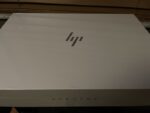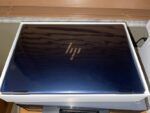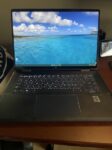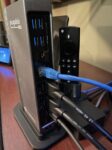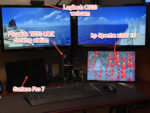 Hey, just so you know ... this post is now about 2 years and 2 months old. Please keep that in mind as it very well may contain broken links and/or outdated information.
Hey, just so you know ... this post is now about 2 years and 2 months old. Please keep that in mind as it very well may contain broken links and/or outdated information.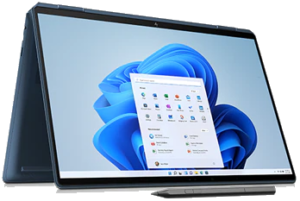
I thought I tended to upgrade my home PC roughly every 5 years but looking back I got my Dell mini-tower in 2008, then built my current desktop, the Intel NUC in 2015, a gap of 7 years. And now in 2022, another 7 years later my new desktop is … a laptop.
I don’t know why it took me so long to decide to make my daily driver a laptop. I got the NUC primarily because I had just gotten a standing desk and wanted something small to sit on top. And when I was away from home, I usually had my work laptop/Surface with me. But as I was considering my next “desktop” PC I realized a big laptop as a desktop replacement made sense. I’m not a gamer so I don’t need an extreme graphics card (which are hard to come by now anyway), I have a good multi-monitor setup since I work from home so I wouldn’t need to stare at a laptop screen all the time, and a docking station could easily make up for the extra ports I use.
After performing my usual research, I decided to go with the hp Spectre x360 16 2-in-1 convertible laptop.
My Spectre x360 16 has the following specs, compared to the NUC it replaced:
| hp Spectre x360 16 | Intel NUC |
| Intel Evo 11th gen Core i7-11390H @ 5.0GHz | Intel 5th gen Core i7-5557U @ 3.10Ghz |
| 16gb RAM | 16gm RAM |
| 512gb SSD (+32gb Optane) | 250gb SSD |
| Intel Iris Xe graphics | Intel Iris 6100 graphics |
| 1 HDMI port | 1 mini HDMI port / 1 mini DisplayPort |
| 1 USB 3.0 Type A port | 4 USB 3.0 Type A ports |
| 2 Thunderbolt 4 ports | N/A |
| Windows 11 Home | Windows 10 Pro |
Since it’s a laptop, it also has things my NUC didn’t, like a 5MP webcam (which HP calls the GlamCam), 3K (3072 x 1920) touchscreen, fingerprint reader, pen/stylus, and, of course, it’s portable (and can convert into a tablet). Ok, it’s a little big and heavy (4.4lbs) but I don’t travel that much anymore and it actually lets me get out of my home office and out onto the couch when I want to. Another benefit of the larger model is the keyboard and touchpad. The model I bought from Best Buy also came with an active stylus pen (which attaches magnetically to the side, like my old Surface Pro) and a leather sleeve. I’ve been running Windows 11 on my NUC via the Windows Insider Program since August of last year (after a lot of fussing around with TPM 2.0 and other stuff) but now with the Spectre I have an “official” Windows 11 PC.
But since it’s a laptop, it’s also missing some of the extra ports I require when it’s sitting on my desk acting like a desktop PC. To address that I also added the Plugable TBT3-UDZ Thunderbolt 3 docking station which has 6 USB 3.0 ports, 1 USB C port, gigabit ethernet, two DisplayPort/HDMI ports, SD and micro SD slots, and an audio jack. In its vertical orientation it actually takes up less space than the NUC and when connected to the Spectre via Thunderbolt, gives me a one cable connection to drive my two external monitors, connect to the wired network, and power the laptop without needing the bulky HP charging brick (which can stay in my backpack, ready for travel). Very slick.
I’ve only had the laptop for a few days so most of the time I’ve spent with it has been re-installing my apps and re-configuring all the settings to my liking (all of my personal stuff is stored in OneDrive and the NAS so that part was easy), but so far am very happy with it. I also spent a good amount of time re-organizing my desk and re-wiring everything in for the docking station and figuring out where to put the Spectre when it’s in “desktop” mode. I settled for “tent mode” where the screen is folded back into an upside-down V where all I see is the screen and the keyboard is in the back. This means the screen is technically upside-down with the hp logo at the top and the webcam at the bottom. That makes the webcam useless for video calls (and Windows Hello) since all it shows is the surface of my desk, but I have a USB Logitech C920 connected to the docking station mounted on top of the monitors that works around that. So even though it’s weird seeing the upside-down hp logo (which looks like “dq” when the Spectre boots), it’s easier to get to the power button than if I used the orientation where the screen was still right side-up but the keyboard was flat against my desk (hard to explain in writing) and the screen orientation flips properly once Windows boots. Now I have the option for three monitors when using the Spectre (2 external monitors plus the internal display).
For additional reading, here’s Engadget’s review of the Spectre x360 16. I’ll post more thoughts as I continue to familiarize myself with the Spectre!
- unboxing 1
- unboxing 2
- keyboard
- Spectre x360 16
- Plugable dock
- new standing desk setup
